Gonzo journalism on the lip of Horseshoe Bend… 34 miles in the desert with my best friends… roadside quesadillas and a beverage called “Gnarly”… hope springs eternal from an open blister… sandy redemption and liquid revenge… the freaks we met along the way… the freaks we found inside…
I WANT TO TELL YOU ABOUT THE RACE. I was thinking about it while I was running, actually, because I had so much time. And I had all these crazy things to say about the pain: about how I became so accustomed to it that I could tuck it behind my ear like a strand of wet hair, about how my legs operated independently like off-leash dogs, about how I had a sand dune in each shoe, solely mine, just to play with. And there was this silence — oh, you would have hated it! On all our practice runs we’d wax poetic about life and love and Ada Limon, and here we were without the breath to talk. But I’m getting ahead of myself. I want to tell you everything: about riffing in the hotel, about Angelika on the edge, about the start line in the blue dawn, the tease of those pink flags, the water station on the edge of the world. It’s a long story, longer than it has any right to be, but certainly shorter than eight hours. “There will be time, there will be time,” said T.S. Eliot, or maybe it was Hannah in a transatlantic accent. I guess if I’m telling the full story, it only makes sense to start in medias race…
So join me, I guess, on the Page Rim Trail. It’s sixty degrees with a slight breeze, which is to say that the weather ceases to exist at all. The sun coats the flat expanse of the Arizona brush, and it’s all so beautiful that it’s chewing a hole in your iPhone battery, on airplane mode in your left vest pocket. You can hear the crash of their breath — two of the best people you know, your dearest friends, your comrades in Hell. The soundtrack is this: the snap of your braids against your hydration packs, the swish of your shorts, the soft thud of your trail shoes, muffled by sand. And all of it is remixed by Hannah Good saying, “we are so lucky to do this,” while completing the most wretched task imaginable.
At no point do you know where you are, but it’s okay, because Courtney Beesch does. She has the course map memorized, she knows where the aid stations are, and none of your GPS watches are accurate anyway. Not that it’s very helpful to look at them. Until the near-end, the remaining mileage will be unfathomable — that kind of thing can bum you out if you let it.
It’s not just you three, of course. You have been running with the same group of people this whole time. You see each other at aid stations and offer a high-five, a spare orange wedge, a conspiratorial nod. After a while, everyone blends into one species of animal: Sunscreen-coated pickle juice guzzlers downing candy like sunflower seeds and sucking saltwater from their own nylon teats. Freaks, all of you. You can spot a freak instantly if you are a freak yourself, having already donated your toenails and dignity to a sport that gives barely anything in return. It’s not like running an ultramarathon makes you cool, or hot, or rich. In fact, the training process for this consumed all of my free time, deleted my ass, and swallowed three hundred dollars like a Kentucky sinkhole with a taste for Corvettes. But I have been restless all my life, and this madness: it gave me somewhere to go. Every spare morning and afternoon became a breeding ground for ten-mile runs. I was terrified of my own commitment to it. I had to forge my own memes and craft Strava captions with calculated levels of snark and bemusement so that people might find me sane and willing. This is all to say: I was a freak like the rest of them. I enjoyed it, damn it. We all did. When we smiled at each other at the aid stations, I could see myself in their sunglasses, upside down and polarized.
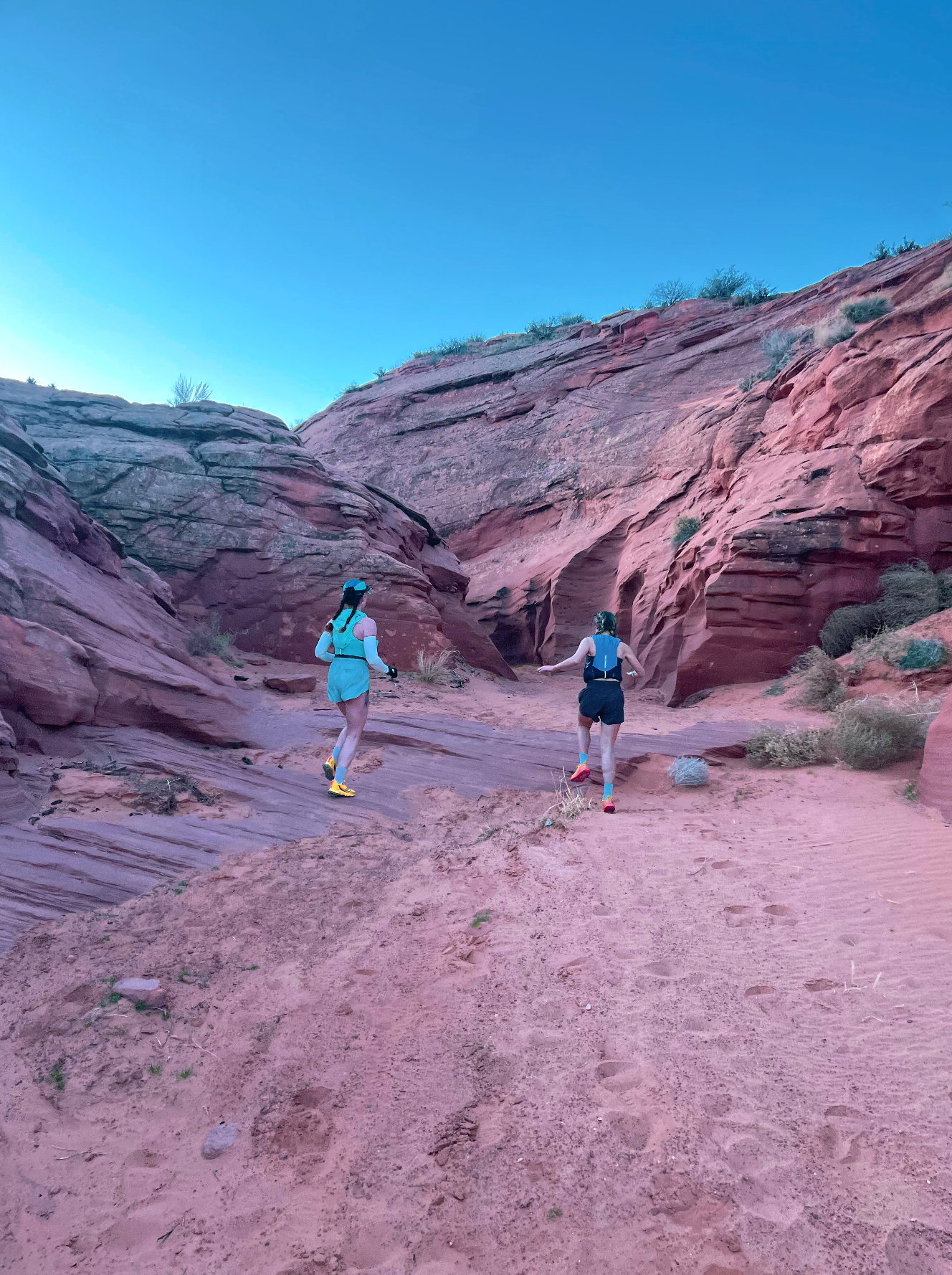
Our first wrong turn, though it did allow us to glimpse a slot canyon.

The aforementioned "blue dawn"
So you’re there, right? Can you picture it? It’s okay if you can’t — I posted pictures on Instagram. But imagine you are here, and despite all this drudgery, if you can believe it, there is joy: joy beneath the sand that rubs a layer of skin from the arch of each foot, joy within the bramble lashes that criss-cross your calves, joy woven into the braids that snap when they hit your shoulders, hardened with sweat.
You hear the faraway mumble of a crowd, and above it, our voices.
“That’s the aid station.”
“Holy—”
“Already?”
“Yeah, right on that hill.”
“Does that mean we’re at mile—”
“Twenty-seven, I think Courtney said.”
“No way.”
“Oh my God. I see Sam.”
“Oh, in the white shirt!”
“That’s them, I see them.”
“We’re so close, guys. We’re so close.”
“Just ‘til the top of the hill.”
“We got this. Easy.”
You fix your eyes on the white tents of the Lake Powell aid station. If the course map is correct, you must be approaching Mile 27. Over a marathon beneath your feet, already — can that be true? You’re mainlining liquid from two straws on either side of your vest. The left sack is empty. The right is filled with a jungle juice compiled over the past five hours from Nuun tablets, an electrolyte beverage known only as Gnarly, salt-laden pickle juice, and the finest of sink water from Page Arizona’s La Quinta Inn. When we get to the crest of this hill, you can fill up. Courtney can dump out her shoes. Hannah can top off the sunscreen. This will be your last aid station. Reaching it will be a triumph. You are six hundred feet from the chute at its entrance… five hundred… four hundred… three… Your toes dig into the sand, falling a step backward with each one.
You’ve been at this, now, for five hours.
You have thirteen miles to go.
How does one cope with a campaign of this length? If you’re me, and you’re halfway through a Hunter S. Thompson book about the 1974 election, this recap starts penning itself on your forehead. You think to yourself: I will write Fear and Loathing. But instead of the campaign trail, it’s just the trail. And instead of running for office, we’re just running. And instead of Rolling Stone breathing down my neck about deadlines and expense reports, I write every word voluntarily and without a single ounce of amphetamines, which makes me about as far from Hunter S. Thompson as I am from the finish line. But he and I have one thing in common: with a hater mentality, we can survive just about anything.
*
HST’s critically-unacclaimed final book about the 1980 Honolulu Marathon, The Curse of Lono, starts on an airplane — and coincidentally, so does ours. I only know how this book starts because I read it six days ago in the living room of Courtney’s childhood home. Her parents are incredibly welcoming people — the kind of people that, upon hearing that I was reading HST, brought me into the other room as though to show me a great treasure and presented me with the coffee table book version of The Curse, the limited-edition version interspersed with full-color artwork by Ralph Steadman. I stood in this room for fifteen minutes in the middle of a party, reading about the man with the blue arm, hearing the voices from the other room. But I’m getting ahead of myself.
What was I saying? The plane! And not the kind of vessel you’re thinking about — no, wipe any image of a monstrous and culturally-relevant Boeing 777 from your mind. This plane had two rows of two seats and it was so small that you could see the cockpit from every seat, which they quickly put to an end by yanking a tiny curtain across. Hannah and I ended up on this little guy after waiting in Terminal C of Ronald Reagan National airport for eight hours. Why we had to do this could be explained in another, less interesting story about a series of mistakes entirely within our control. But all you need to know is that we were sitting very far apart, and I was seated next to this woman that many would deem “A Karen.”
She heard I had been moved up to row 8 from the back of the plane — this was true. Apparently her husband had been back there too and she was grumbling that they should have moved him up instead. “It’s fine. I don’t care,” She said, though she said it so many times that it negated the sentiment. “I see him every day anyway.” I did what any sane person would do, at that point, and I waited until the flight attendants finished their safety speech to switch seats with her husband. And lo and behold, when the drink cart rolled out later in the flight, this couple had sent a glass of white wine to me. I was stunned. I had not planned on drinking, but I am not one to turn down a free glass of wine. I had never drank at altitude, and it was a generous pour — one of those mini bottles, turned upside down in a plastic cup, at least two or three glasses worth — and by the time we touched down in St. Louis, I was drunk. Hannah had to pilot my tipsy ass to the next gate to make our connection. We only had eight minutes between flights, so I never got to find those generous people and thank them.
I boarded the next flight feeling devious. When the flight attendants asked for my drink order, I asked if I could send white wine to Hannah in the back. I expected hesitancy on their end, but was met with giddy excitement. “She’s in row 30, you said? What does she look like?” I don’t remember what I said, but whatever it was, I think they were all convinced that I had only just met her at the gate and I was being wickedly flirtatious. They proceeded to bring her the wine with a sort of performance and zeal restricted to meddling gay American Airlines flight attendants. They went back to her seat and poured the wine from a tall height like trickster waiters. They pinched me on the shoulder to say it had been delivered, and for the rest of the flight, any time they interacted with either of us, their eyes gleamed. They never asked for my card, and so somehow we got two glasses of white wine on American Airlines that day without paying for a single one of them. We are so lucky! (reprise)
Courtney and Sam are waiting for us in the airport. We haven’t seen Courtney since the ski accident when her boyfriend broke his rib and punctured a lung; we haven’t seen Sam ever. When I reach to hug him, I do it lightly, but at this point he only wears a brace on one wrist. The next hug is tighter, when my arms close over Hannah and Courtney. I mash my head to the side so that all of us fit together.
*
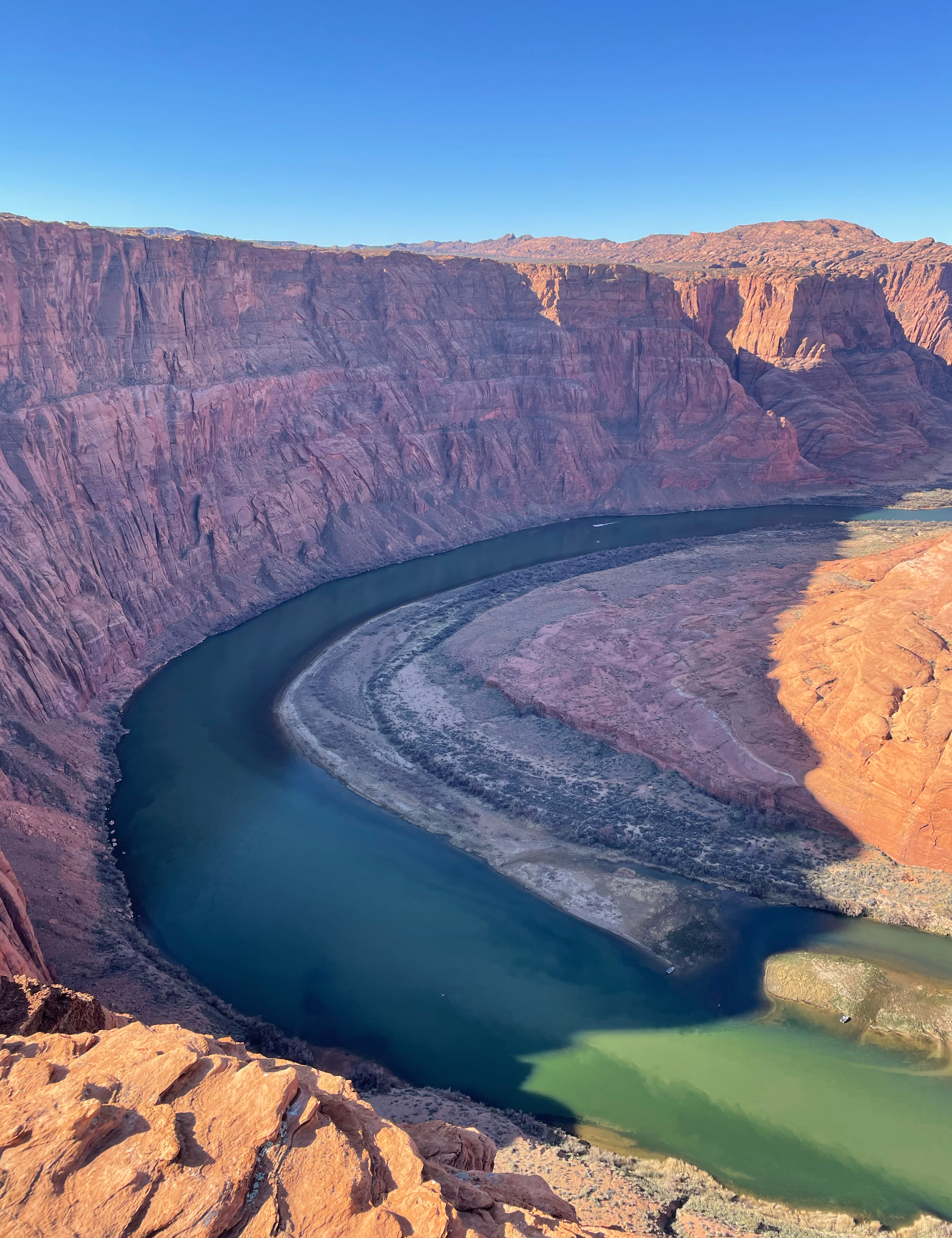
The left arm of Horseshoe Bend
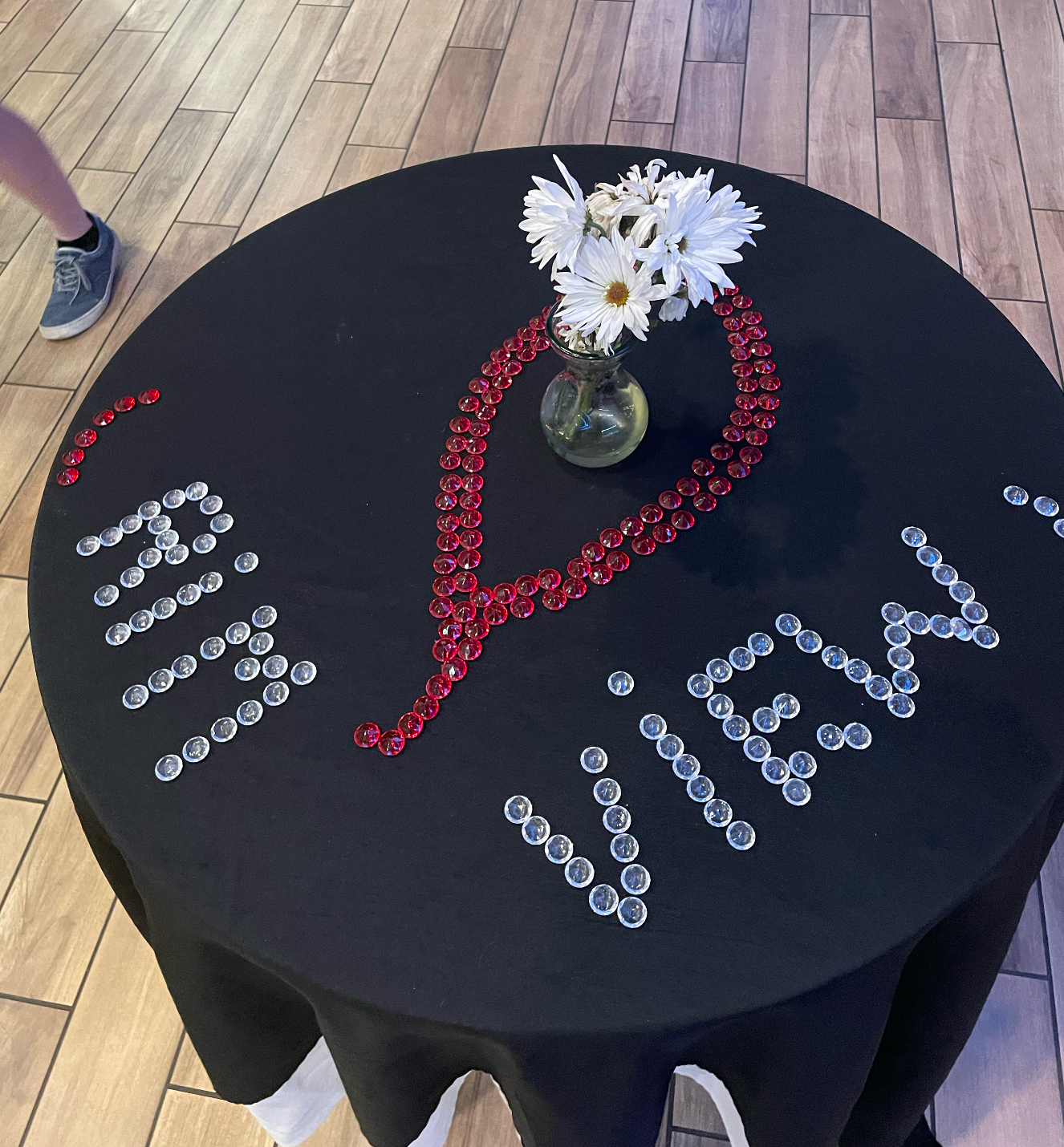
I wish I was making this up
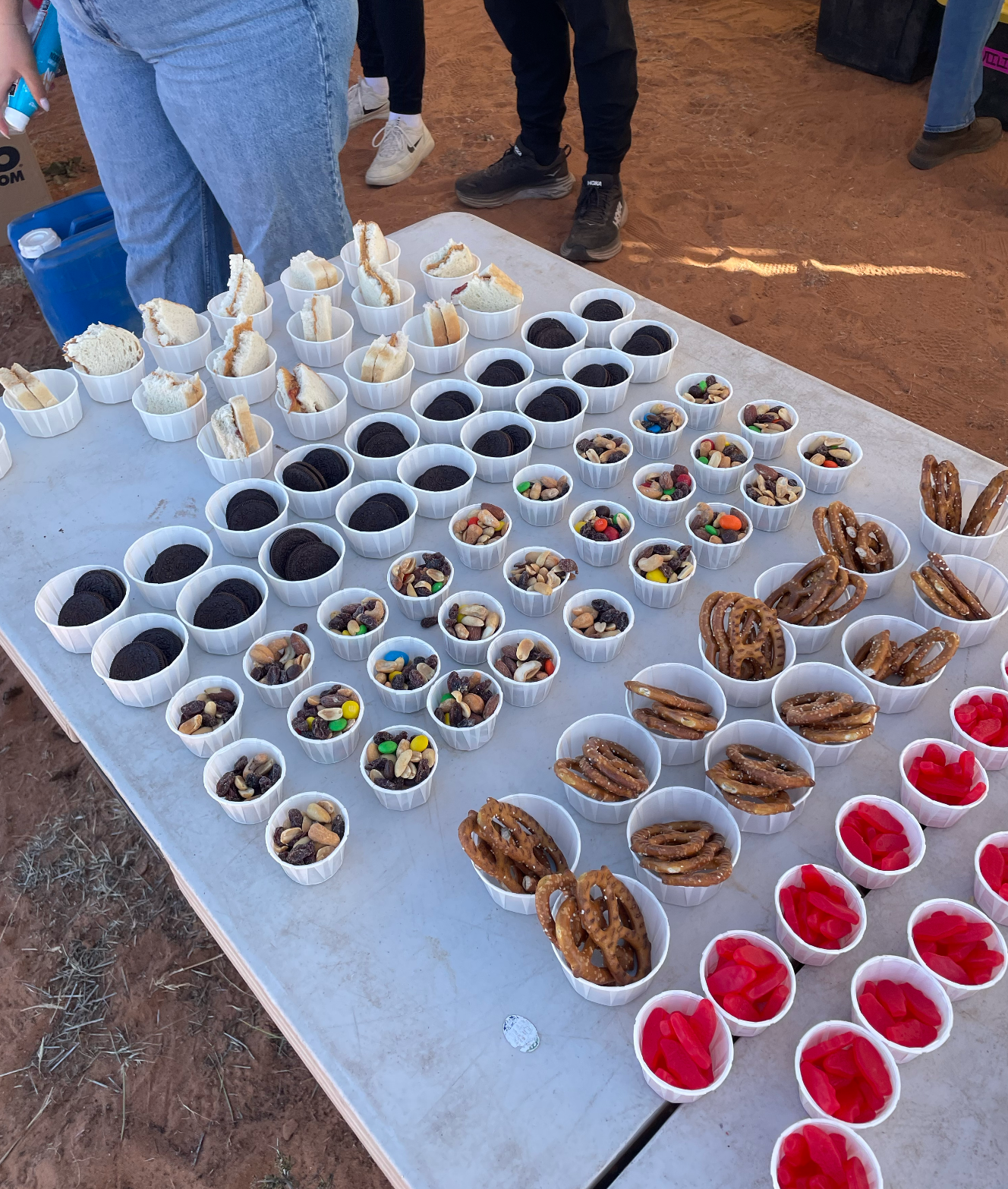
A small section of the aid station snack table
The Antelope Canyon 55K course is two loops: one around Horseshoe Bend and the surrounding Navajo land; another around Page Arizona’s rim trail. The course is denoted in some places, not by a formal path, but by a scavenger hunt of pink flags snaking through the open desert, crumpled into bramble or speared with thin wire into rock. “The course is overmarked, if anything,” They tell us. Which is true for most of it. But in a few places, we get lost. And every time, the entire group will turn around like a school of fish, chuckling at our shared folly.
We wake up at 5 a.m. on race day. We share one cup of hotel room coffee, but we barely drink it. We apply glitter to our cheeks in the bathroom. We douse ourselves in sunscreen and body glide. We tug on our matching tank tops, our hydration vests, our Garmin watches. We tie our hair into double braids: two brown, two blonde, two red. We make a slow jog to the startline, do a couple pitiful stretches, join the crowd of two hundred other runners, see my parents and Courtney’s parents, take a moment for a land dedication to the Navajo Nation, steel ourselves for the countdown, and then take off into the blue dawn.
*
We meet Austine on the rocky outcropping overlooking Horseshoe Bend. Her kelly green tank top feels incongruent against the orange rock. We offer to take a picture of her, but she declines.
“Part of me wants to stop and take it in,” She says. “But the other part of me really wants to run this competitively.”
I feel old. She hasn’t realized, yet, that this is not the kind of race that you race. We’re only a few miles in and it’s become clear to our group that this is not so much a run as it is a hike with occasional opportunities to fast-forward between sand traps. It’s one of the universal discoveries of trail running that you have to walk. It’s just as fast to walk up a sand dune as it is to pitifully jog. And by all means, when you are presented with one the the most glorious formations of the natural world, you stop and take a thousand pictures with your dirty dirty iPhone.
I am thinking this when Austine takes a picture of us on the ridge of Horseshoe Bend. I am also thinking about steadying my body over the balls of my feet. There is no fence. At all moments, we are two lazy steps from falling 4,200 feet to our death, and worse, DNF-ing this race.
“Do any of you know what mile we’re on?” Austine asks, when we start running again.
I glance at my watch. “Five down.” I leave the obvious part unsaid: thirty more to go.
There’s a moment of silence in which I hear the smack of her road shoes on rock.
“That’s great,” She says finally, but I can see her tugging her octave upward on invisible string. “That’s farther than I thought.”
*
I should probably mention how we trained for this. Whenever we say that we ran an ultramarathon, it’s one of the first questions people ask: How do you prepare for that? Did you run a marathon? And then we grin like fools. We’ll never forget knocking the socks off our server at Ted’s Bulletin. “Did you guys run a marathon this morning or something?” And how fucking funny it is to say yes.
So anyway: the training. Courtney had an actual plan crafted by one of her friends who offers coaching. Hannah found a training program online at Outside Dot Com. And I mooched off of Hannah’s program but actually did not listen to a single day of it and just did whatever I wanted. But all three of these plans had one thing in common: back-to-back long runs. Instead of marathon training, where you peak on a Saturday and then recover on Sunday, ultra training asks you to run your hardest distance on Saturday and then another long run the next day so that you get used to running on tired legs. I thought I would hate this, but I did not. (Freaks!) It made the long runs feel less holy. I got less nervous for them, since I knew I’d be doing them multiple times a week. It trained my body to recover at light speed. It meant I got twice as much time on the C&O Canal Towpath, one of the greatest loves of my life. The only downside was that it erased half the weekend. And so we made the most of these runs by doing a few of them together.
(I should mention: I was simultaneously training for the Boston Marathon. It was your classic Two Dates at Prom situation, wherein I had to flirt with both speedwork and endurance training in attempts to make both of them think I was dedicated. In the end, my true love will always be long-distance running. We all know this.)
I will not bore you with the details of the training. I will only mention that it was the purest form of girlhood I have ever known: we’d wake up and make each other coffee, we’d split a waffle, we’d trot through New York and D.C. with the sunrise, we’d bemoan the seven lives we could have lived had we not chosen this one, we’d watch the figs shrivel and die at our feet, we’d discuss tattoo ideas and plan matching outfits for the race and psychoanalyze our parents and recount every person we’ve ever dated and what they taught us. And at the end we’d get coffee and brunch and we’d tap our fingers on the table with a deviousness. We’re going to run an ultramarathon, we would say.
Of all the ways this race changed my life, the friendship is the part that I am most proud of. Hannah mentioned off-handedly that it had been a sleeper hit of the training to become better friends with me, which feels like an understatement. To be one-third of a team containing Courtney Beesch and Hannah Good, two of the strongest and ambitious and funniest people I know, is to be luckiest person of all. I watched myself grow into the truest version of myself just by being better friends with them — and what it joy it has been to get to know someone as intimately as you can when you have three hours a weekend to spend with them. It would all be worth it for that alone.
When we decided we were doing this a year earlier in a Brooklyn coffee shop, we were friends, but not nearly this close. I agreed to this plan like a sixth-grader making a marriage pact. You would think that a major life decision like training and completing a trail ultramarathon would have to be verified by some federally-mandated third party, or at least God. Surely somebody would tell me I wasn’t strong enough, that I didn’t have enough free time to train, or that it was simply a dumb thing to do. But nobody did, not even once.
I have written many essays about this revelation, and somehow still I am writing another one. It is like that movie, Fifty First Dates. I learn this lesson every day, forget it by sunrise, and then wake up the next day to learn it all over again. And so I say this for my future self, again and again: In this life, you can do whatever the hell you want and they won’t stop you.
*
We’re at the aid station at mile 21 when Courtney rushes at Hannah and I, a bright smile on her face. “GUYS!” She exclaims. “We only have a half-marathon left!”
To understand what an insane moment this was for us, allow me to explain the situations surrounding. An ultramarathon is a cycle. At a certain point, you begin to lose track of time and mileage and find yourself in a state of anomia in the desert, motivated at all times by the voices of your friends, the bobbing colorful bodies of the runners ahead of you, and the sight of the next pink flag. After enough time, someone will announce that the aid station is not very far away. You will start planning. You will think, when I get to the aid station, I will unlace my shoes and dump out the sand. I will apply Vaseline to the stinging patch under my arm. I will tighten my vest. I will drink a cup of pickle juice and I’ll wash it down with water. I will get in line for the snack table, and while I am in line, I’ll roll out my ankles. I haven’t had the Swedish Fish yet — maybe this is the time to start eating the Swedish Fish. Then I will retie my ponytail. I will wipe the gritty sweat from my forehead. I will peel the dead skin off my lip. I will adjust my pack so that the zipper doesn’t bounce. And then you get to the aid station, and you do those things, and you are reborn like a phoenix. You start running again, you are new, your legs are fresh, nothing to indicate the miles that lie behind you but the gelatinous residue of gummy candy on the backs of your teeth, which you can play with for the next hour. There are aid stations every seven miles, or so, and you get this experience four or five times throughout the race.
And when you have exhausted every aid station, you have nothing to look forward to except the end. This is the best motivator of all. You might even speed up, finding a previously untapped reserve of energy in your legs. (We called this phenomenon “Going Bonnie-mode” after our graphics colleague and famed ultramarathoner Bonnie Berkowitz.) Many of you might hear this story and think we are all insane. Imagine it, instead, like this: you are Sisyphus, and suddenly, you see the lip of the top of the hill, and the boulder is steady in your hands, and you realize that after an eternity of the slog, you might just actually make it.
*
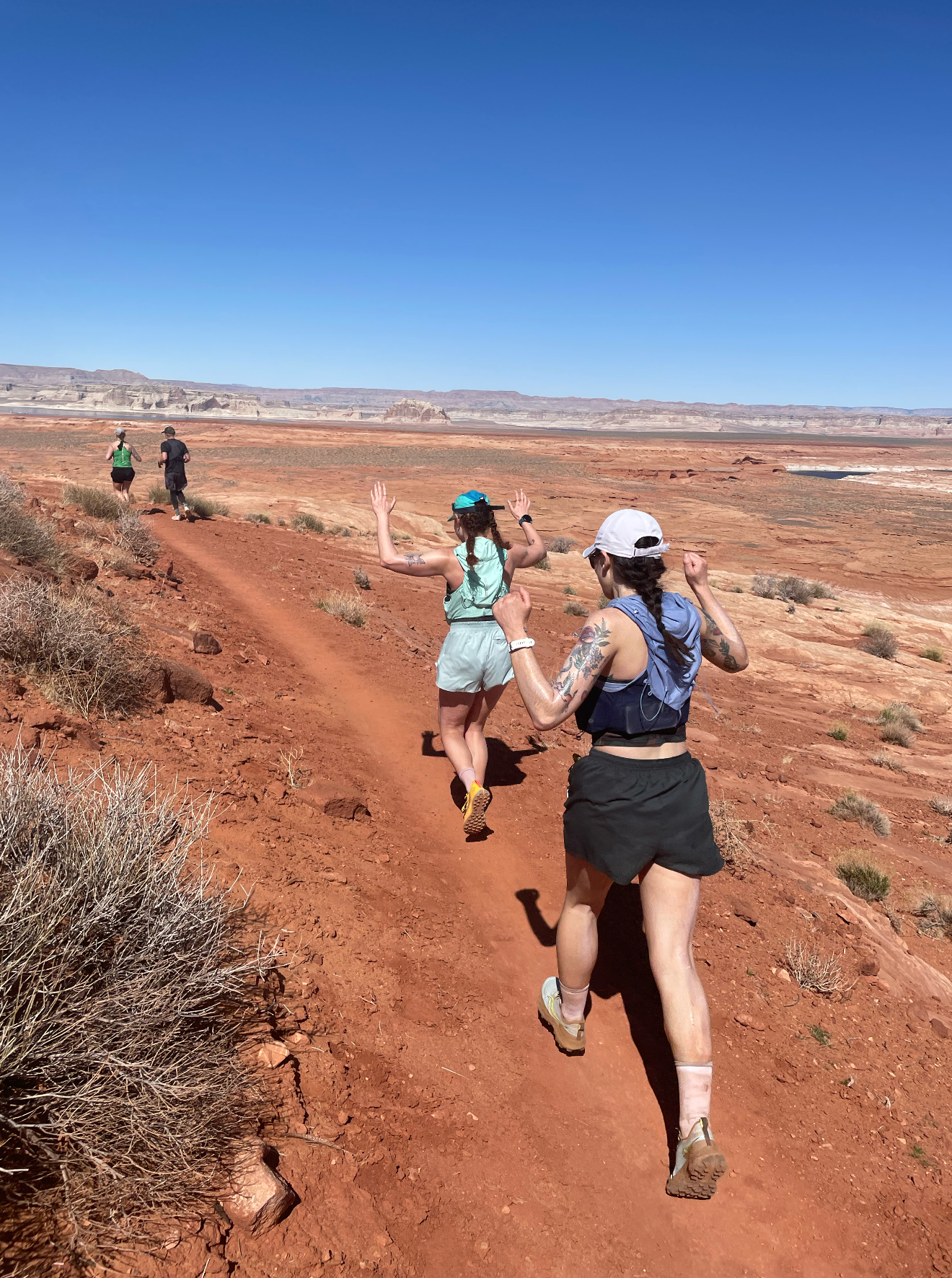
Going "Bonnie-Mode"
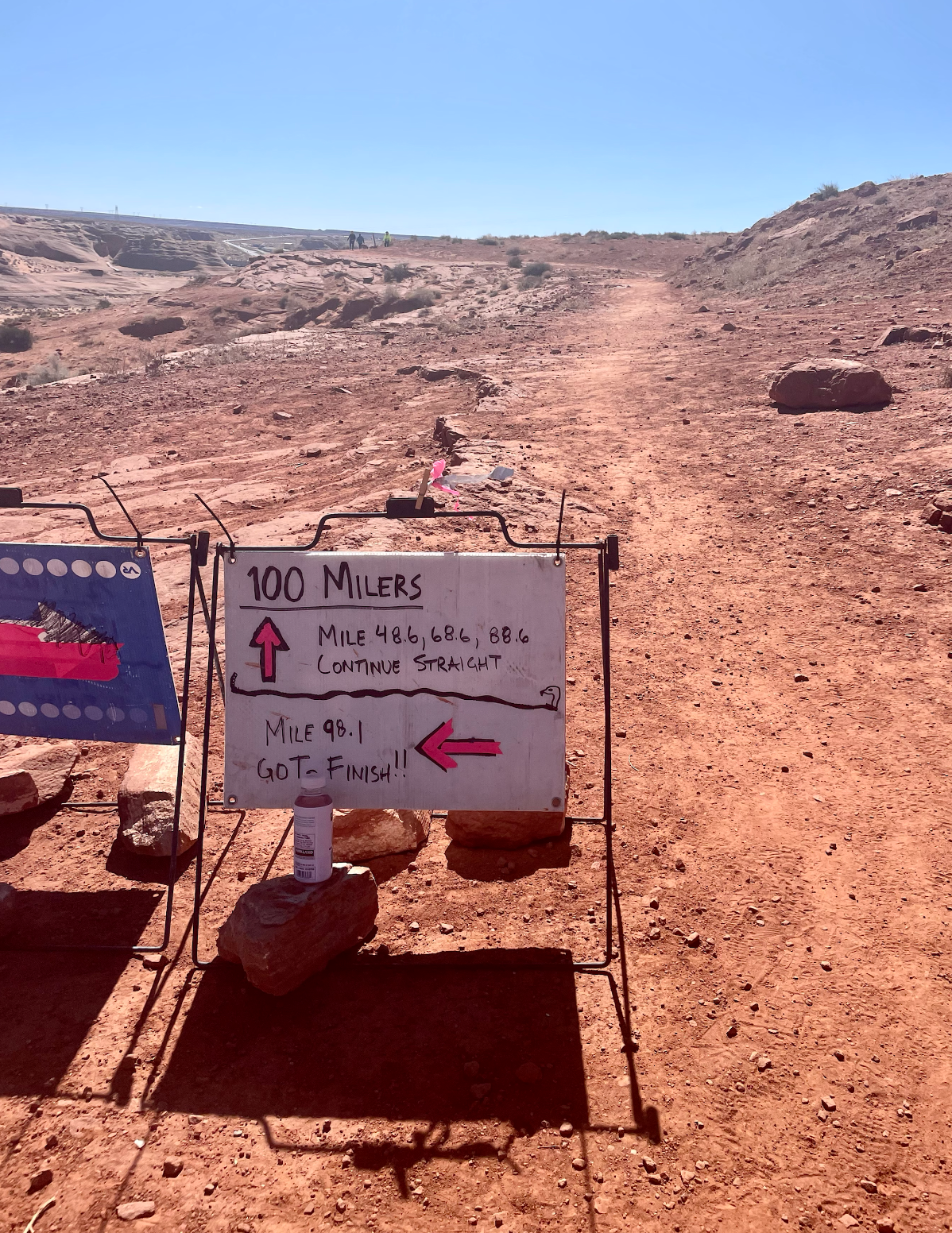
Dune 2 looks crazy here
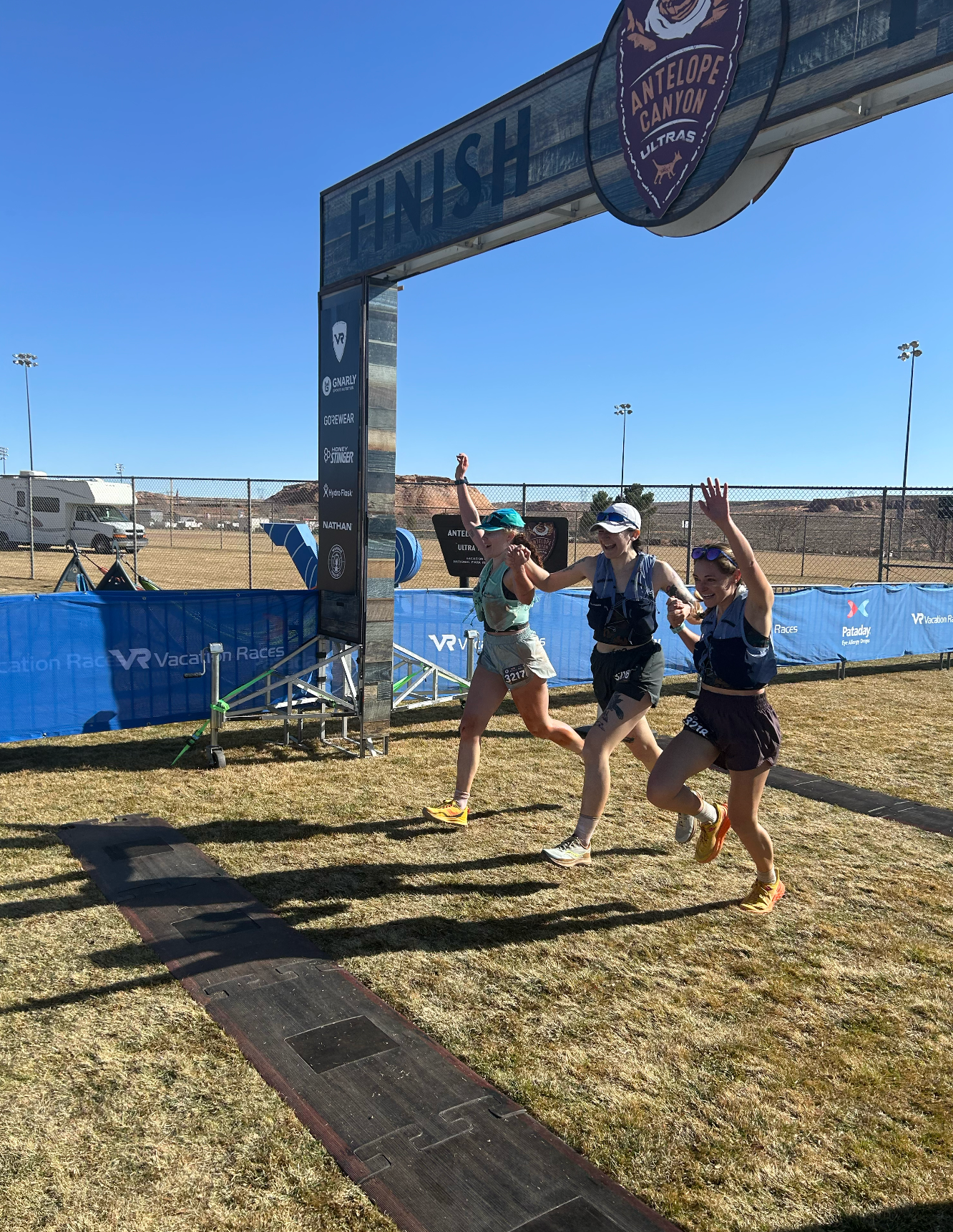
Euphoria at the finish line
The race goes on, as it must. At mile two, I am offered a quesadilla. I decline. It haunts me for five miles. The next time I am offered a quesadilla, at mile thirteen, I accept it. Growing up in Wisconsin prepares you for one of the sleeper challenges of an ultramarathon: the dairy intake. From this aid station onward, I will eat three more quesadillas. And two Oreos. And two peanut butter and jelly corners. And two watermelon wedges, three orange slices, and sixteen grapes. I am like The Very Hungry Caterpillar if he did cardio.
To pass the time, I force everyone to play a game wherein we name chain restaurants in alphabetical order, which is like a concussion test for the mind-numbing effect of long-distance running because something that would have been normally easy has our brains firing on all cylinders. Hannah takes puffs of her inhaler and I delight in the occasional smell of albuterol. We develop our own unique blisters and our own unique ways of ignoring them. At some point, we discuss whether or not we believe in the concept of true love.
We have just summited the course’s worst incline when we meet Angelika. She sits on the ledge beside a metal bridge and we join her, shaking the sand from our shoes. She offers sage wisdom, a sick Russian accent, and magic blister bandages with medicated ointment. “I did Rim to Rim to Rim last year,” She tells us. “And these saved me. Whatever you do, don’t take them off.”
At this corner, there is no aid station, only a massive water canteen the size of a refrigerator. There are signs denoting the course: turn left if you’re running 100 miles, right if you’re doing 50. It perches on a cliff so small it might as well be the edge of the Earth.
Whether it’s the bandages or the trail magic of meeting Angelika, I am not sure, but we continue running with a newfound hope. We pass the brilliant blue of Lake Powell that slices the landscape between Arizona and Utah. Near the end of the Page Rim loop, we leave nature and reenter town, jogging around the hotel chains and a local golf course, whose occupants ogle us with the blank stares of aquarium fish. We are descending back into Page Valley when Courtney falls. My heart catches in my throat, for a minute, before she lets out a shaking laugh. “I literally did train for this,” She reminds us, having fallen the week before on a training run. And I find myself laughing too.
As we round the final curve into the finish chute, we see Courtney’s parents and Sam’s parents and Sam himself, who has procured a traffic cone somewhere and held it to his lips, his cheers coming to us through the frame of its rubber sole. (I have deemed this “The Megacone.”)
After the race, we will find our friends from the trail. We will wish a happy birthday to Austine’s mother. We will thank another runner for reminding us to apply sunscreen. Angelika will airdrop a video she took of us on the trail. To our surprise, we turn the sound on to find that we are laughing. We will switch shoes to accommodate our blisters. I will eat a final quesadilla, but at this point, it will taste sour — the magic of the race will be over, and I will return to feeling neutral about quesadillas. We will limp across the parking lot. I will brush a tear off my face, and my finger will come back full of glitter.
But at this moment, that hasn’t happened yet. We are still running. And after so much time on the course, it suddenly seems like everything is moving too fast. We have a quarter mile, and then two hundred meters, less, and Hannah grabs one of my hands and one of Courtney’s, and then the announcer is calling our names: “It’s Emma… and Hannah.. and Courtney…” in the booming voice that Courtney would later describe as the world’s softest WWE introduction. Everyone is screaming: the announcer, the crowd, Sam through that damn cone. But my world has narrowed to the bodies on either side of me and it all comes rushing back to me: all the training, all the miles and the malört and the gu and the chafing and the laughter and the poetry and the riffs and the sand and the glory. And this is it — this is it! There would be a moment when we missed this race, but right now it pales in comparison to how badly we needed this damn thing to end. When I look at the pictures of it now, I realize I lifted Hannah’s hand above my head, and I think I might be crying.
And: surprise! There is a bottle of champagne waiting for us in the hotel room, courtesy of Courtney’s parents. There is a glorious shower followed by a toast, sipping bubbly from the plastic cups meant for mouthwash. When the liquid hits my tongue, there is carbonation, but it fades into a taste I recognize: the same spontaneous sweetness of American Airlines, of a gift I do not deserve. I have the same thought when the cup leaves my lips. How lucky am I, how lucky am I. How fucking lucky am I.
*
A week after the race, Mother Nature bestows DC with what is perhaps the loveliest day of all time. My typical routine is to do a series of four pathetic stretches while I wait for my watch to link, but on March 16th I burst out the doors of my apartment like a colt from the gates. I have my phone on me, for once, with the sole purpose of making voice recordings to compile them into an essay later.
And I do. I run twenty miles down the C&O Canal Towpath and the burn in my legs returns like an old friend. I hear their breath again, behind my shoulders. The jokes resurface as if they live in a vault that you can only unlock with hard effort. And the story unfurls beneath my road-rubbed Asics and I speak it aloud into my phone recorder. When you listen to it back, you can hear the metronome of my feet on the path, faraway enough that it kind of sounds like sand. The walkers on the trail look at me like I’m crazy. But the runners don’t bat an eye.
